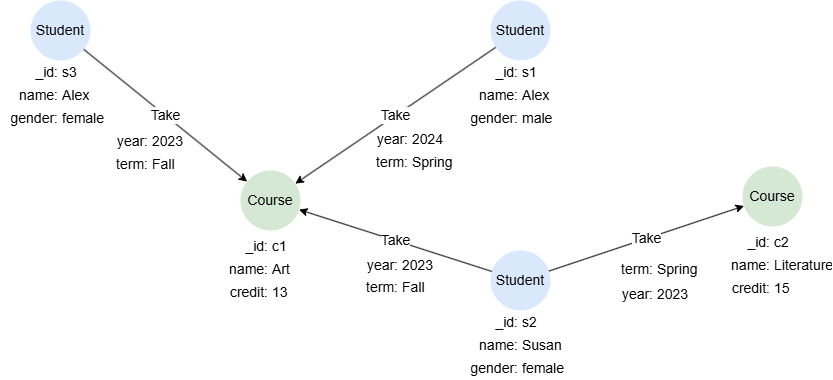Overview
The GROUP BY clause allows you to specify the set of grouping keys to be used during grouping on the final table.
<return statement> ::=
"RETURN" [ "DISTINCT" ] { <"*"> | <return item list> }
[ <group by clause> ]
<group by clause> ::= "GROUP BY" <grouping key list>
<grouping key list> ::=
<grouping key> [ { "," <grouping key> }... ]
<grouping key> ::= <binding variable>
Details
- Each grouping key must be a binding variable. If the desired grouping key is not already an existing binding variable, you have two options:
- Renaming using
AS: If the grouping key is part of the final result table, you can rename the corresponding column using theASkeyword. - Using
LET: Alternatively, you can use theLETstatement to define a new variable for the grouping key before theRETURNstatement, ensuring it is available for grouping.
- Renaming using
- After grouping, only one record in each group will be returned.
- When grouping is involved, any aggregation operation in the
RETURNstatement is applied to each group after the grouping is done.
Example Graph
The following examples run against this graph:

To create this graph, run the following query against an empty graph:
INSERT (alex:Student {_id: 's1', name: 'Alex', gender: 'male'}),
(susan:Student {_id: 's2', name: 'Susan', gender: 'female'}),
(alex2:Student {_id: 's3', name: 'Alex', gender: 'female'}),
(art:Course {_id: 'c1', name: 'Art', credit: 13}),
(literature:Course {_id: 'c2', name: 'Literature', credit: 15}),
(alex)-[:Take {year: 2024, term: 'Spring'}]->(art),
(alex2)-[:Take {year: 2023, term: 'Fall'}]->(art),
(susan)-[:Take {year: 2023, term: 'Fall'}]->(art),
(susan)-[:Take {year: 2023, term: 'Spring'}]->(literature)
Grouping by One Key
MATCH (:Student)->(c:Course)
RETURN c GROUP BY c
Result: c
| _id | _uuid | schema | values |
|---|---|---|---|
| c1 | Sys-gen | Course | {name: "Art", credit: 13} |
| c2 | Sys-gen | Course | {name: "Literature", credit: 15} |
Grouping by Column Alias
In this query, the grouping key Name is the column alias of n.name:
MATCH (n:Student)
RETURN n.name AS Name GROUP BY Name
Result:
| Name |
|---|
| Alex |
| Susan |
The following query throws syntax error as the grouping key n.name is not a binding variable:
MATCH (n:Student)
RETURN n.name GROUP BY n.name
Grouping by Variables Defined by LET
In this query, the grouping key Gender is defined by the LET statement:
MATCH (n:Student)
LET Gender = n.gender
RETURN n GROUP BY Gender
Result:
| n |
|---|
| (:Student {_id: "s1", gender: "male", name: "Alex"}) |
| (:Student {_id: "s3", gender: "female", name: "Alex"}) |
The following query throws syntax error as the grouping key n.gender is not a binding variable:
MATCH (n:Student)
RETURN n GROUP BY n.gender
Grouping with Aggregation
MATCH (n:Student)
RETURN n.name AS Name, count(n) GROUP BY Name
Result:
| Name | count(n) |
|---|---|
| Alex | 2 |
| Susan | 1 |
Multi-level Grouping
MATCH ({_id: "c1"})<-[e:Take]-()
RETURN e.year AS Y, e.term AS T GROUP BY Y, T
Result:
| Year | Term |
|---|---|
| 2023 | Fall |
| 2024 | Spring |

